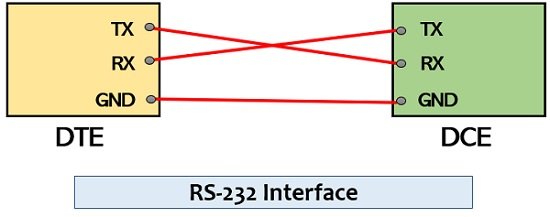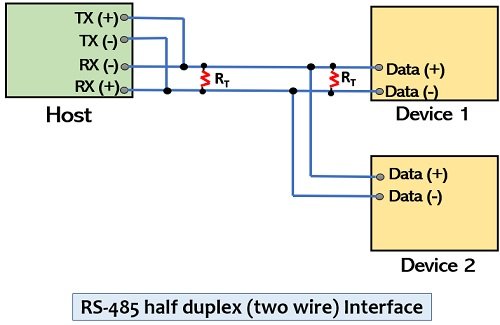RS-232 and RS-485 are the two types of standard serial communication protocols. Both are used to facilitate serial communication between devices however, the two are different in many ways. The significant difference between RS-232 and RS-485 is noticed on the basis of their data cable type. RS-232 offers the single-ended type of line configuration. On the contrary, RS-485 offers a differential type of line configuration.
RS-485 is known to be the advancement of RS-232 that supports technological upgradations.
What are serial communication protocols?
In the case of an embedded system, a set of pre-defined rules that facilitate the transfer of data bits between two programmed units one after the other, is known as serial communication protocols. RS-232 and RS-485 are asynchronous types of standard protocols, where transmission and reception are not clock synchronized.
Here RS stands for Recommended Standards.
Such cabling standards are set by organizations like the Electronic Industry Association (EIA) and the Telecommunication Industries Association (TIA). At earlier times, prefix RS was used before cabling standards. But nowadays it has been replaced by the prefix EIA.
Content: RS-232 Vs RS-485
Comparison chart
| Basis for Comparison | RS-232 | RS-485 |
|---|---|---|
| Basic | Single mode of data transfer | Differential mode of data transfer |
| Number of transmitters and receivers | 1 | 32 |
| Communication mode | Full duplex | Full duplex or half duplex |
| Cost | Less | Comparatively more |
| Topology | Point to point | Multipoint |
| Transmission type | Unidirectional | Bidirectional |
| Cable length | 50 feet | 4000 feet |
| Data rate offered | 20 kbps | 10 Mbps |
| Operational distance | Less | Comparatively more |
| Logic level | ± 3 V to ± 15 V | ± 200 mV to ± 6 V |
| Noise immunity | Less | More |
| Receiver input resistance | 3K to 7K ohms | More than 12K ohms |
| Signaling type | Unbalanced | Balanced |
| Driver load | 3K to 5K ohms | 60 ohms |
| Receiver sensitivity | ± 3 V | ± 200 mV |
| Applications | In embedded systems for programming PLCs, servo drives, etc. | In computing and automation systems like robotics, video surveillance, motion controlling, etc. |
Definition of RS-232
RS-232 serial cabling interface came into existence in the year 1962. It is known to be the oldest cabling method to form a connection between data terminal equipment and data communication equipment. For example connection of computer system with a printer.
The figure below represents an RS-232 interface between two devices:
It is clearly shown that it has single transmitter and single receiver nodes along with a ground terminal. The command from an end to the other via cable is sent using voltage signal. It defines logic 1 as voltage level between – 15 to – 3 V whereas logic 0 as voltage level between + 3 to + 15 V. The voltage ranging between -3 to +3V is the undefined state.
We have already discussed that it is an asynchronous type of protocol where a clock signal is not provided. So, here the unidirectional transmission takes place in a way that to intimate the receiver regarding the transmission, a start bit is sent initially, after which the actual data sequence is sent. Also, this complete sequence is followed by parity bit and stop bit to provide the intimation to the receiver regarding completion of the sequence.
Definition of RS-485
RS-485 serial cabling interface invented in 1998 is known to be an advancement of RS-232 that suits the technological advancement of the present world. This communication protocol holds the ability to handle 32 connected devices which were only 1 in the case of RS-232. Thus, it has 32 transmitter and 32 receiver terminals by which multiple devices of a single system can be connected easily.
In RS-485, when the voltage level varies between -200 mV to -6 V then, at the receiver end it is interpreted as logic 1. Whereas if it varies between + 200 mV to + 6 V then it will be logic 0.
When a system is incorporated with RS-485 then the twisted pair cable arrangement offers long-distance transmission at high speed which suits various industrial applications. Before the arrival of RS-485, another standard RS-422 was invented. RS-422 also supported differential mode of operation. However, several limitations were associated with the RS-422 protocol and those limitations were eliminated by RS-485 thus is industrially used.
Generally, it is a two-wire half-duplex system but is sometimes implemented in a full-duplex manner using four wires.
Key Differences Between RS-232 and RS-485
- RS-232 and Rs-485 are data cable types with the help of which data is exchanged between the nodes within a network. The transfer of data between nodes is classified as single-ended and differential.
RS-232 exhibits a single-ended type of data transfer. However, the data transfer offered by RS-232 was quite ineffective for long-distance, thus, RS-485 was used that is of differential type. - The network topology supported by RS-232 is a point-to-point type because it simply connects two devices. While the network topology supported by RS-485 is multipoint in nature as multiple devices can be connected by this cabling approach.
- An RS-232 has 1 transmitter (driver) and 1 receiver only. As against, RS-485 has 32 transmitters (drivers) and 32 receivers present on a single bus.
- The signaling type of RS-232 is of unbalanced nature whereas RS-485 offers the balanced type of signaling.
- The cable length of an RS232 cable is around 50 feet which is comparatively quite small in comparison to RS485 having a cable length of 4000 feet. If the cable length of RS-232 is exceeded beyond 50 feet then resistance and voltage drop become an issue.
- The data transfer rate offered by rs485 is nearly 20 Mbps whereas that of rs232 is 10 kbps. A huge limitation of rs232 was its transmission speed and to deal with it rs485 came into existence.
- RS-485 is used for a comparatively longer distance of transmission than RS-232. This is so because rs232 has a lower transmission speed thus is inefficient for longer distance transmission.
- RS-232 is less immune to noise in comparison to RS-485 because 485 operates on the differential mode that reduces the effects of ground shifts and induced noise in the network. Also, this helps in dealing with issues related to data collision.
- The receiver input resistance offered by 232 ranges between 3K to 7K ohms. While it is comparatively higher in the case of 485, with a value of more than 12K ohms.
- The driver load of RS485 is 60 ohms which is less than that of RS 232 that ranges between 3K to 5K ohms.
Conclusion
Thus, according to the specifications of the two serial interfacing methods, RS-232 finds applications in embedded systems like programming of PLCs, servo drives, etc. While RS-485 is used in computing and automation systems like robotics, the light controlling system at performance venues, etc.


